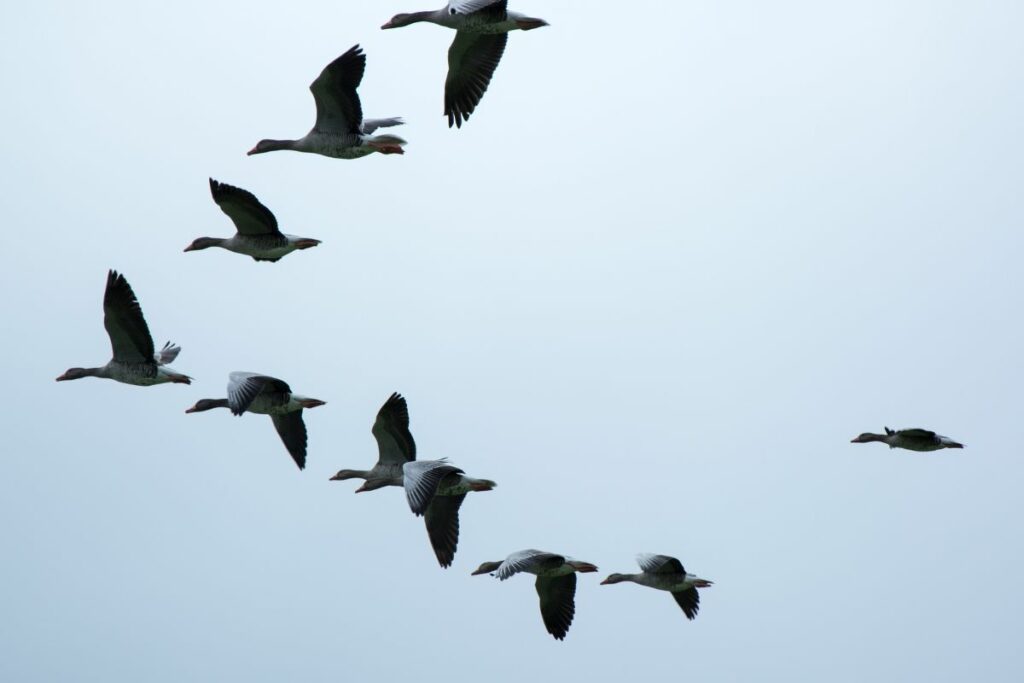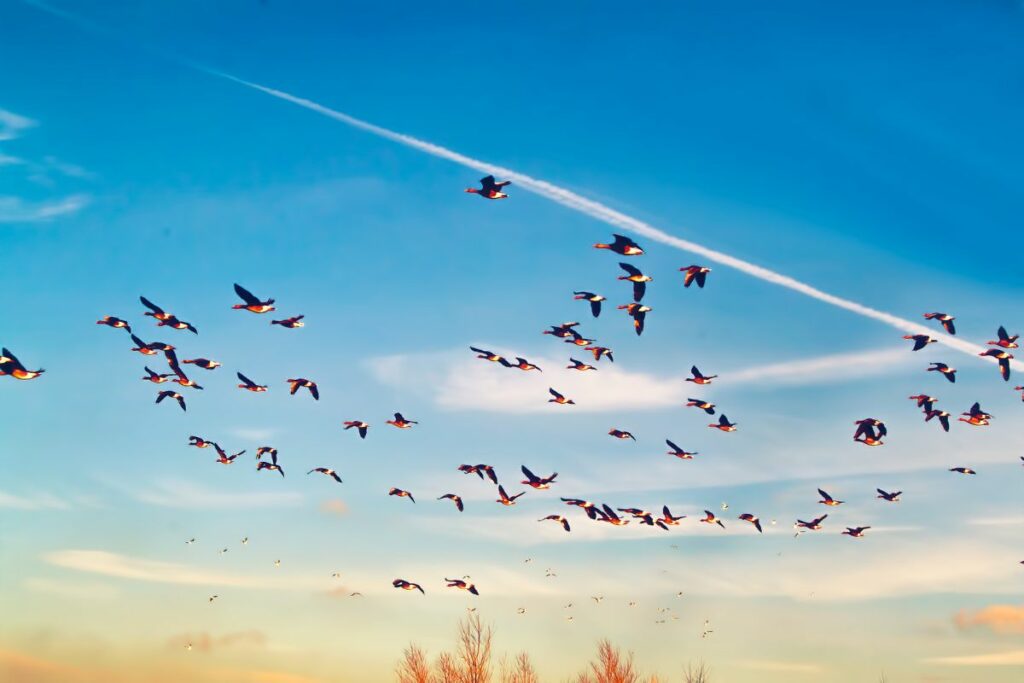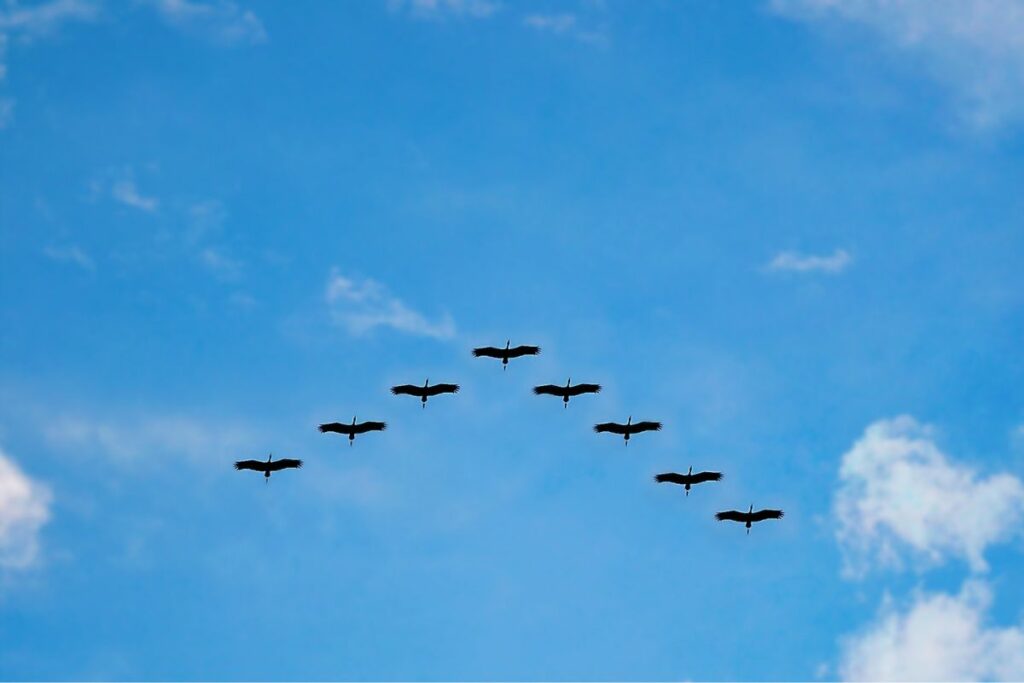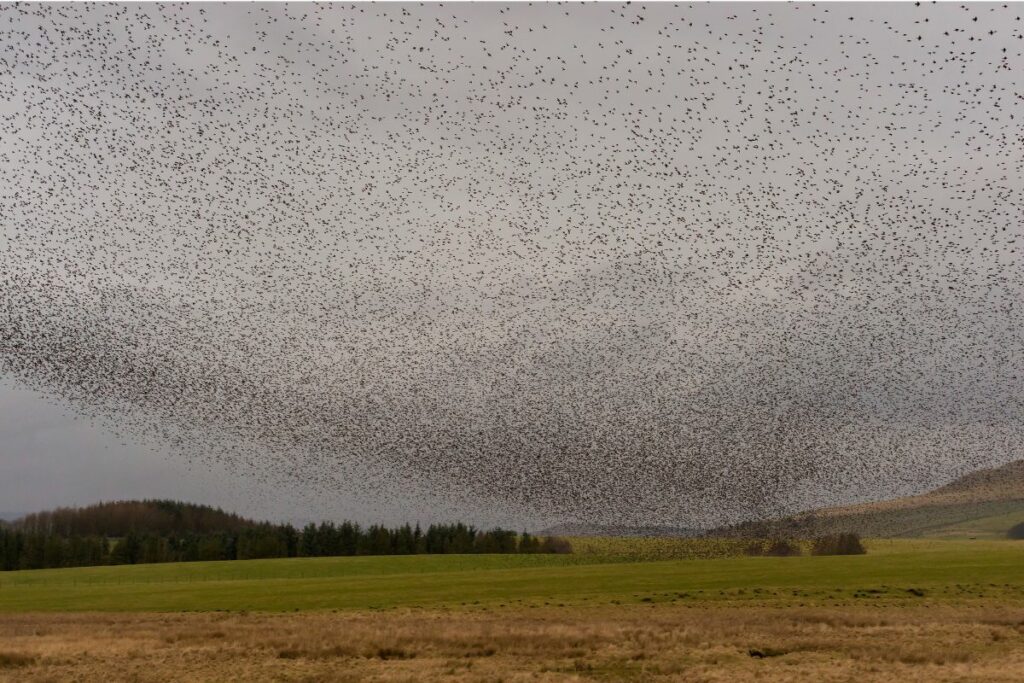As an Amazon Associate, we earn from qualifying purchases with no additional costs for you.
You have probably marveled at the sight of a flock of birds flying overhead. You may wonder why some species of birds tend to fly in flocks.
There are a couple of reasons why birds fly in a flock. Birds can gain protection from predators that become confused by the flock. Flying in a flock can be aerodynamically better, and feeding in a flock can help stir up food.
Read on to learn more details and information about why birds like to fly in flocks. You can also learn about the types of birds that tend to flock together.
TIP: If you want to check out the best pair of binoculars for bird watching, we recommend a pair of waterproof and fog-proof 8 x 42 binoculars like the Celestron – Outland X 8×42 Binoculars (Amazon link).
Why Do Birds Fly In Flocks?
A reason birds fly in flocks is to protect them from predators. The idea is that in a large flock, there are more chances of a bird spotting a predator and giving an alarm signal, which alerts all the other individuals to the presence of danger.
The other advantage is that a predator may be confused in a large flock. It can, thus, help protect a single bird by associating with others in a large flock.
When Do Birds Flock Together?
Some species, like Bronze Mannikins, occur most often in flocks during wintertime. During the breeding season, they occur more often as pairs. Mannikins will often feed together in big flocks. Since they are very small birds (at only 9 to 10 cm long), they gain protection from being in a flock.
At a food source, one individual Mannikin stands guard while the others feed. Other small birds that can often be found in flocks are the Orange-breasted Waxbills and Common Waxbills.
Orange-breasted Waxbills have been observed flying in a flock with a Fiscal Shrike in pursuit, trying to catch one of the birds. Waxbills are also small birds that are susceptible to a range of predators, so flying in a flock offers protection.
Mixed-Species Flocks
Some birds occur in flocks along with other species, such that the flock is a mixture of different bird species. These mixed-species flocks sometimes forage together where there is a rich source of food.
There are some ideas about why birds may congregate in mixed flocks. It may help to confuse predators, but it also may increase feeding efficiency.
This is because the movement of the birds through foliage can flush insects that can then be grabbed by other birds that are close by. Titmice and Chickadees often forage together in flocks.
Woodpeckers, like the Downy Woodpeckers, are also sometimes seen associated with the Chickadees and Titmice in mixed flocks.
Mixed-species flocks can be seen all around the world. In South Africa, you can find feeding groups of Cape White-eyes, Willow Warblers, Bulbuls, and others all in a single tree. Birds may occur in mixed-species flocks where the food source is concentrated, for instance, in a small wetland area.
Birds That Migrate In Flocks
Several species of birds migrate in flocks. This includes waterfowl in North America, such as Snow Geese, which migrate in flocks of thousands of individuals. Geese are not the only waterfowl to migrate in large flocks. Duck species like the Blue-winged Teal also migrate in flocks.
One reason birds may migrate in a flock is that it does confer protection against predators. Since there are so many eyes looking out, a predator can be more easily noticed if you are in a flock. Again, a predator may be more confused by a large number of birds flying together than a single bird.
TIP: Knowing how to spot the birds in your yard is key to enjoying visits from your winged friends as much as possible! The best sources are trusted books, I recommend using the following (Amazon links):
– National Geographic Field Guide to the Birds of North America
– National Audubon Society Birds of North America
Why Do Birds Often Have A V-Formation Flight Pattern?
Migrating birds often fly in a particular formation known as a V-formation. The V-shape is thought to be the aerodynamically best choice for the birds. It is thought that the birds can catch the updraft from the bird in front, such that they do not have to expend as much energy flapping.
The results of a study on flight in the Northern Bald Ibis lend support to this idea of energy conservation.
Do Hawks Fly In Flocks?
Most raptors are found alone or in pairs and are not particularly social. However, conditions sometimes encourage these birds to occur in flocks. A rich feeding source, for instance, flying termites in Africa, can attract several Yellow-billed Kites.
These birds then occur together and feed together on the wing. The kites use their feet to catch the termite alates flying in the sky.
Another reason hawks may flock together relates to thermals. The thermals make flying easier as the birds do not have to flap as much to stay aloft. You can then find several of the hawks occurring together in the sky where these updrafts are. A group of circling raptors is referred to as a “kettle.”
Many raptors migrate in large numbers, and can occur in large flocks in Panama, which acts as a funnel for these birds since they migrate over land.
What Are Murmurations?
These are usually large flocks of Starlings that fly around, making interesting patterns in the sky. These murmurations are amazing to watch. Scientists think that murmurations are a good way for birds to confuse predators. A falcon may find it hard to focus on catching a single bird when there is a flock of a thousand flying around in a group.
Murmurations may also serve as a method to attract other starlings to join the group and even roost in the group at night. Roosting together is a good way to stay warm when there are cold nights, and may also help against predation as birds can warn others of danger.
Conclusion
Birds fly in flocks because it is a good strategy for reducing predation. The other reason for birds to fly in flocks is that it can be aerodynamically useful as birds flying behind a leader can position themselves in the air so as to catch the updraft from the leader bird.
This makes flight easier. Several types of birds fly in flocks, including waterfowl, raptors in thermals, and birds like starlings.




